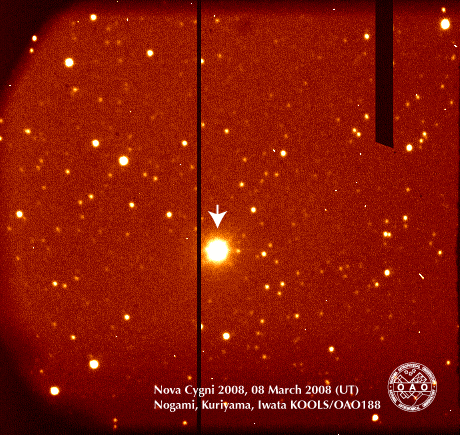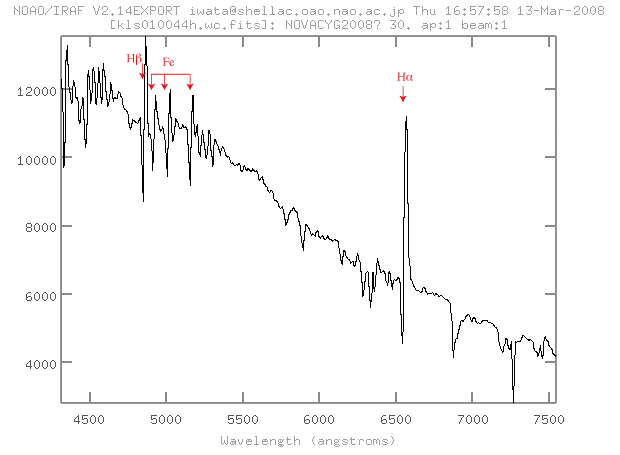KOOLS: Kyoto Okayama Optical Low-dispersion Spectrograph
News
Publications
[2016/08/03]
In list of publications Horiuchi et al. (2016) was added.
End of KOOLS open-use
[2015/10/01]
It was decided that the open-use operation of KOOLS with OAO 188cm telescope will be terminated by the end of March, 2017.
Publications
[2014/08/19]
In list of publications Kuroda et al. (2014) was added.
Publications
[2014/06/12]
List of publications is now open.
Spectroscopy ETC
[2010/03/18]
Exposure time calculator for point-source spectroscopy is now provided as a beta service. Please refer Sensitivity section for more information.
On OAO2010B Call for Proposals
[2010/03/09]
Open use call for proposals (JP, EN) is out. There are some special notes:
KOOLS(Kyoto-Okayama Optical Low-dispersion Spectrograph, PI-type instrument): KOOLS offers two basic observing modes, namely, imaging and long-slit spectroscopy, in optical wavelength for the OAO 188cm telescope. From 2008A the instrument has been open to common use as a PI-type instrument on a shared-risk basis. Applicants who want to use the instrument should contact Dr. I. Iwata (ikuru.iwata [at] nao.ac.jp) prior to the submission of the proposal, at least one week earlier to the deadline. His admittance is madatory for the proposal submission; any proposal without his admittance will be declined. Specifications of the instrument and results of past test observations are available on the instrument web page. In the semester 2010B, there may be some restrictions on the scheduling of programs using KOOLS. Plase ask the instrument PI for details. In addition, there is a possibility of a close of the open use of KOOLS from the semester 2011A.
We also plan to provide a web-based ETC (Exposure Time Calculator) shortly. Until it is available, please refer Sensitivity section in the specification page.
KOOLS manuals updated
[2009/10/21]
Manuals are slightly updated, including the section of trouble shooting and Grism Wavelength Coverage Calculator has been added.
Improvement of CCD Linearity
[2009/08/04]
There has been a problem in linearity of KOOLS CCD; if a CCD count exceeds 10,000 ADU (for the case without binning) significant deviation from linear relation has been observed. By adjusting resistors in on MFront "SIGADC" board, the linearity has improved. For the case without binning, a good linearity is achieved up to 27,000 ADU. For the case with 2x2 binning, the linearity is achieved up to ∼30,000 ADU. More details are available in the Development section (in Japanese). Also, the time required for shutter movement affects linearity if the exposure time is less than 25 seconds. Care should be paid if the exposure time is ∼10 seconds or less.
New Slits and HCT
[2009/04/03]
New slits (1.8" and 3.0") are available. Also, we replaced FeNeAr HCT Lamp. Please refer Operation Manuals.
KOOLS manuals updated
[2008/09/09]
KOOLS manuals are updated significantly. We will update these manuals from time to time. Please send any questions or comments to ikuru.iwata [at] nao.ac.jp, to improve usability of the instrument.
KOOLS status report at OAO UM 2008
[2008/08/25]
We made a status report at OAO users meeting held in the Mitaka campus, National Astronomical Observatory of Japan on 2008/08/19-08/20. PDF of the slides shown there is available.
We also updated the sensitivity section of the specification page with recent analyses.
Dr. Nogami and Mr. Kuriyama confirmed Nova Cyg 2008 using KOOLS
[2008/03/12]
Dr. D. Nogami and Mr. J. Kuriyama, Kyoto University and Dr. I. Iwata, National Astronomical Observatory of Japan, obtained a low-dispersion spectrum of a nova candidate reported by Mr. H. Kaneda on Mar. 8.794 UT with the OAO 188cm telescope and KOOLS. The spectrum shows strong Balmer and Fe II lines having prominent P-Cyg profiles. The FWHM of the emission component of Hα is about 1000 km/s, and the minimum of the Hα absorption is blueshifted from the emission peak by about 880 km/s. These features suggest that this object is indeed a classical nova before or around maximum.
Dr. Nogami reported the result immediately after the observation and the report has been published in IAU circular No. 8927.

V-band image of Nova Cygni 2008. Black areas are CCD bad columns.

Two-dimension spectrum of Nova Cygni 2008.
KOOLS with No. 5 grism and 1.8" slit was used.
Exposure time is 30 sec and the resolution is ∼500.
 Spectrum of Nova Cygni 2008 with KOOLS.
Prominent P-Cygni profiles can be seen
in Balmer and FeII lines.
Spectrum of Nova Cygni 2008 with KOOLS.
Prominent P-Cygni profiles can be seen
in Balmer and FeII lines.